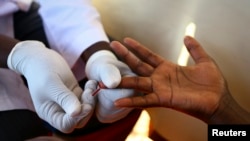New HIV infections and deaths from AIDS are decreasing, making it possible to control the epidemic by 2030 and eventually end it “in every region, in every country,” the United Nations said Wednesday.
“More than ever before, there is hope that ending AIDS is possible. However, a business-as-usual approach or simply sustaining the AIDS response at its current pace cannot end the epidemic,” the organization’s UNAIDS program said in a new global report issued ahead next week’s international AIDS conference in Melbourne, Australia.
It said the number of people infected with HIV was stabilizing at around 35 million worldwide. The epidemic had killed some 39 million of the 78 million people it has affected since it began in the 1980s.
“The AIDS epidemic can be ended in every region, every country, in every location, in every population and every community,” Michel Sidibe, UNAIDS’ director, said in the report. “There are multiple reasons why there is hope and conviction about this goal.”
The human immunodeficiency virus (HIV) that causes AIDS can be transmitted via blood, breast milk and by semen during sex, but it can be kept in check with cocktails of drugs known as antiretroviral therapy or ART.
UNAIDS said that at the end of 2013, some 12.9 million HIV positive people had access to antiretroviral therapy – a dramatic improvement on the 10 million who were in treatment just one year earlier. Only five million got AIDS drugs in 2010.
Infection, death rates decline
Since 2001, new HIV infections have fallen by 38 percent, UNAIDS reported. AIDS deaths have fallen 35 percent since peaking in 2005.
The U.N. report said ending the AIDS epidemic by 2030 would mean that the spread of HIV was being controlled or contained, with significant declines in ill health, stigma, deaths and the number of AIDS orphans.
“It means increased life expectancy, unconditional acceptance of people's diversity and rights, and increased productivity and reduced costs as the impact diminishes,” the report said.
According to UNAIDS, $19.1 billion was available from all sources for the AIDS response in 2013. It estimated a need for at least $22 billion a year by 2015.
Redoubled effort encouraged
But entire countries are being left behind, facing the triple threat of high HIV burden, low treatment coverage and no or little decline in new HIV infections.
Fifteen countries account for more than 75 percent of the global burden of new HIV infections, the report shows. Three countries in sub-Saharan Africa – Nigeria, South Africa and Uganda – account for 48 percent of all new HIV infections.
Sidibe told VOA that war and struggling government healthcare systems pose barriers to testing and treatment in the Democratic Republic of Congo and some other African nations.
He said the international community should seize the opportunity to turn the epidemic around.
“We have a fragile five-year window to build on the rapid results that been made,” he said. “If we accelerate all HIV scale-up by 2020, we will be on track to end the epidemic by 2030. If not, we risk significantly increasing the time it would take, adding a decade, if not more.”
He said controlling the epidemic by 2030 would avert 18 million new HIV infections and 11.2 million AIDS deaths between 2013 and 2030.
In 2011, U.N. member states agreed to a target of getting HIV treatment to 15 million people by 2015. As countries scaled up treatment coverage, and evidence showed how treating HIV early also reduces its spread, the World Health Organization (WHO) set new guidelines last year, expanding the number of people needing treatment by more than 10 million.
Jennifer Cohn, medical director of the access campaign for the charity Medecins Sans Frontieres (MSF, or Doctors Without Borders), said millions of HIV positive people still do not get the drugs they needed.
“Providing life-saving HIV treatment to nearly 12 million people in the developing world is a significant achievement, but more than half of people in need still do not have access,” she said. “We know that early treatment helps prevent transmission of HIV and keeps people healthy; we need to respond to HIV in all contexts and make treatment accessible to everyone in need as soon as possible.”
VOA's Lisa Schlein contributed to this report from Geneva, Switzerland.










